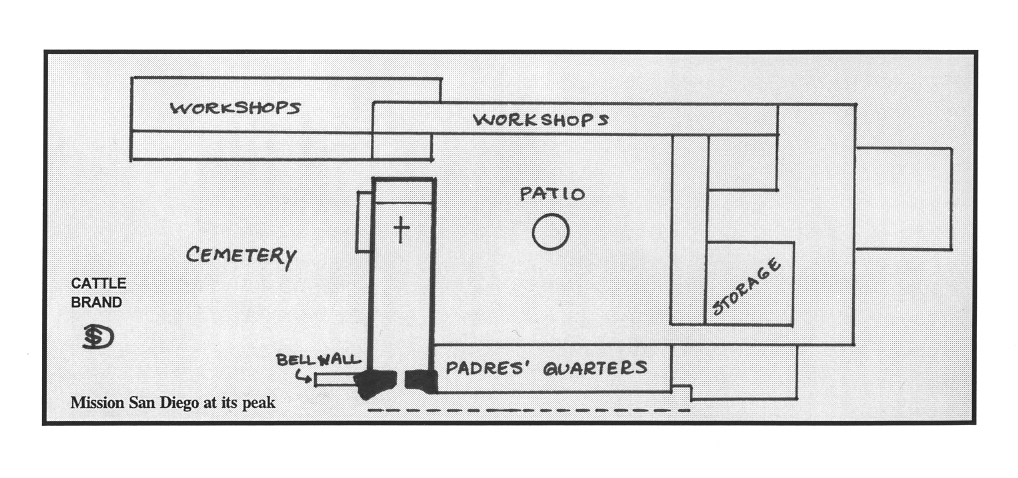| ||||
|
| ||||
|
MISSION
SAN DIEGO DE ALCALA
10818 San Diego Mission Road
San
Diego, CA
92108
Established: July 16, 1769
By: Father Junípero Serra, Franciscan missionary, President of the missions.
Order: 1st of the 21 missions.
Location: 15 miles north of the California-Mexico border, on a hill about eight miles from the Pacific Ocean.
Named: In honor of Saint Didacus of Alcalá, a humble 15th century Spanish friar. (San Diego Bay was first named in 1602 by the Spanish explorer Vizcaíno). Also known as Mother of the Missions.
California Historical Landmark No. 242
DESIGN OF THE MISSION
Church: 135 feet long, 35 feet wide, 29 feet high. Built of adobe. Tile roof.
Style: Simple, setting the standard for the "mission style." The façade (front) is plain, decorated only with a few flat ornamental columns at the side and above the entrance. Wing-like buttresses (supports), added in 1931 to strengthen it, extend from each side of the entrance. An arched corridor crossed the front of the original church, but has not been rebuilt.
Walls: Three feet thick, roughly plastered, with small windows near the ceiling.
Campanario: The bells are hung in openings cut in a wall (called a campanario) that extends like a wing from the front of the church. Five bells are arranged in three rows (two on the bottom, two in the middle, and one on top). The wall is 46 feet high, topped by a wooden cross.
Mission Compound: The group of buildings that made up the mission were built around a square courtyard, 120 feet long on each side. The church was at one corner of this square. Living quarters faced the courtyard, along with the kitchen, storage rooms, blacksmith and carpenter shops, and a granary. Unlike other missions, not many of the Tipai (Kumeyaay) Indians in the area lived at Mission San Diego. Most remained in their own villages.
Mission Grounds: On the 50,000 acres of Mission land were grazing areas for 20,000 sheep, 10,000 cattle, and 1,250 horses. Among crops grown were wheat, barley, corn, beans, and grapes. The mission was known for producing fine wines.
Water System: Water was always a problem for Mission San Diego. In 1807 the Indians at the mission helped the padres build a dam six miles up the river from the mission. Cement troughs carried the water to the mission.
Santa Ysabel: The Franciscans of Mission San Diego built a branch, or sub-mission, about 60 miles east of the main mission, in the Santa Ysabel Valley. The first building was erected there in 1818; an adobe church was built was built a few years later.

EARLY HISTORY
1769 Father Serra and Governor Portolá (of Baja California) arrived at San Diego Bay. Mission site was dedicated on July 16, 1769, with a wooden cross erected on a hill overlooking the Bay. A small chapel was built of brush and branches. The first mission bell was hung on a tree.
1774 Mission moved to a site six miles inland, on the San Diego River, in order to have better soil and more water, and to be further from the soldiers at the presidio (fort). Buildings were made of logs driven into the ground, with tule thatched roofs.
1775 Mission was attacked and buildings burned beyond use. Father Luis Jayme died in the attack. Other missionaries went back to the presidio for safety.
1777-80 Church rebuilt on the burned-out site; made of adobe with beams of pine and poplar.
1792 Roof of tules replaced by tile roof.
1803 Earthquake severely damaged the church.
1807-16 Dam built on the San Diego River to provide better water supply.
1808-13 Final church built, dedicated November 12, 1813.
1834 Mission secularized, transferred from the Franciscans to the government.
1846-52 Buildings occupied by U.S. Army troops and horses.
1862 22 acres of land returned by the U.S. government to the Catholic Church.
MISSION SAN DIEGO TODAY
The mission buildings began to decay and fall apart after 1834, when they were no longer occupied by the Franciscan missionaries. In the 1890's the site was used for an Indian School run by Father Anthony Ubach, who was interested in restoring the mission. However, little was done after 1900, and soon all that remained was the front of the church.
Serious restoration began in 1931 with the rebuilding of the campanario (bell wall) with its five bell niches. Several of the original bells were located. The largest bell in the campanario is the 1200-pound Mater Dolorosa, made in 1894 in San Diego, reportedly from the lead of five original bells that came to the San Diego settlement in 1796 from New Spain (now Mexico).
The restoration of the mission church has been completed as accurately as possible, though few pictures or descriptions exist of the original church. In 1941 the restored mission became a parish church. In 1976, Pope Paul VI named the church a minor basilica because of its historical importance.
A small part of the padres' building is all that remains of the quadrangle. Excavation of more foundations was done in the 1960's by university students. Further excavations of bones and artifacts in 1989 resulted in an area set apart as a memorial to those who died at the mission. At the mission are the graves of five Franciscan friars, including Father Jayme who died there in 1775. There is a small museum, but articles relating to Father Serra, the founder, are in the Serra Museum on Presidio Hill. There, where the mission was first established, is a large cross and a plaque.
